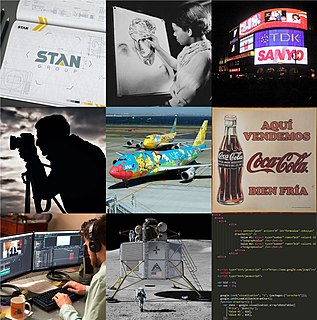
Graphic design is the profession and academic discipline whose activity consists in projecting visual communications intended to transmit specific messages to social groups, with specific objectives. Therefore, it is an interdisciplinary branch of design whose foundations and objectives revolve around the definition of problems and the determination of objectives for decision-making, through creativity, innovation and lateral thinking along with digital tools, transforming them for proper interpretation. This activity helps in the optimization of graphic communications (see also communication design). It is also known as visual communication design, visual design or editorial design.

The ecological footprint is a method promoted by the Global Footprint Network to measure human demand on natural capital, i.e. the quantity of nature it takes to support people or an economy. It tracks this demand through an ecological accounting system. The accounts contrast the biologically productive area people use for their consumption to the biologically productive area available within a region or the world. In short, it is a measure of human impact on the environment.

A graphic designer is a professional within the graphic design and graphic arts industry who assembles together images, typography, or motion graphics to create a piece of design. A graphic designer creates the graphics primarily for published, printed, or electronic media, such as brochures (sometimes) and advertising. They are also sometimes responsible for typesetting, illustration, user interfaces, and web design. A core responsibility of the designer's job is to present information in a way that is both accessible and memorable.
A sustainable business, or a green business, is an enterprise that has minimal negative impact or potentially a positive effect on the global or local environment, community, society, or economy—a business that strives to meet the triple bottom line. They cluster under different groupings and the whole is sometimes referred to as "green capitalism." Often, sustainable businesses have progressive environmental and human rights policies. In general, business is described as green if it matches the following four criteria:
- It incorporates principles of sustainability into each of its business decisions.
- It supplies environmentally friendly products or services that replaces demand for nongreen products and/or services.
- It is greener than traditional competition.
- It has made an enduring commitment to environmental principles in its business operations.

Food miles is the distance food is transported from the time of its making until it reaches the consumer. Food miles are one factor used when testing the environmental impact of food, such as the carbon footprint of the food.
Green brands are those brands that consumers associate with environmental conservation and sustainable business practices.
Sustainability advertising is communications geared towards promoting social, economic and environmental benefits (sustainability) of products, services or actions through paid advertising in media in order to encourage responsible behavior of consumers.

The American Institute of Graphic Arts (AIGA) is a professional organization for design. Its members practice all forms of communication design, including graphic design, typography, interaction design, user experience, branding and identity. The organization's aim is to be the standard bearer for professional ethics and practices for the design profession. There are currently over 18,000 members and 73 chapters, and more than 200 student groups around the United States. In 2005, AIGA changed its name to “AIGA, the professional association for design,” dropping the "American Institute of Graphic Arts" to welcome all design disciplines.
Sustainable advertising addresses the carbon footprint and other negative environmental and social impacts associated with the production and distribution of advertising materials. A growing number of companies are making a commitment to the reduction of their environmental impact associated with advertising production and distribution.
A paperless office is a work environment in which the use of paper is eliminated or greatly reduced. This is done by converting documents and other papers into digital form, a process known as digitization. Proponents claim that "going paperless" can save money, boost productivity, save space, make documentation and information sharing easier, keep personal information more secure, and help the environment. The concept can be extended to communications outside the office as well.

Sustainable packaging is the development and use of packaging which results in improved sustainability. This involves increased use of life cycle inventory (LCI) and life cycle assessment (LCA) to help guide the use of packaging which reduces the environmental impact and ecological footprint. It includes a look at the whole of the supply chain: from basic function, to marketing, and then through to end of life (LCA) and rebirth. Additionally, an eco-cost to value ratio can be useful The goals are to improve the long term viability and quality of life for humans and the longevity of natural ecosystems. Sustainable packaging must meet the functional and economic needs of the present without compromising the ability of future generations to meet their own needs. Sustainability is not necessarily an end state but is a continuing process of improvement.
This page is an index of sustainability articles.
The Cal Poly Pomona College of Environmental Design (CENV) is a college part of the California State Polytechnic University, Pomona. The college houses over 1,600 students; making it one of largest environmental design programs in the United States. The college offers bachelor's degrees in five departments, as well as three master's degree programs. It offers a Master of Interior Architecture, professional degree in collaboration with the University of California, Los Angeles (UCLA).
Sustainable products are those products that provide environmental, social and economic benefits while protecting public health and environment over their whole life cycle, from the extraction of raw materials until the final disposal.
North American collegiate sustainability programs are institutions of higher education in the United States, Mexico, and Canada that have majors and/or minors dedicated to the subject of sustainability. Sustainability as a major and minor is spreading to more and more colleges as the need for humanity to adopt a more sustainable lifestyle becomes increasingly apparent with the onset of global warming. The majors and minors listed here cover a wide array of sustainability aspects from business to construction to agriculture to simply the study of sustainability itself.
R. Michael Hendrix is an American graphic designer and entrepreneur.

Gregory Stanislaus Bennett Jr. is an American graphic designer and artist based in York, Pennsylvania, USA. Bennett studied graphic design at the Art Institute of York where he graduated from in 1999. He is best known for his imaginative and highly conceptual branding, corporate identity, packaging and cause-related poster projects.
Eco-friendly dentistry aims at reducing the detrimental impact of dental services on the environment while still being able to adhere to the regulations and standards of the dental industries in their respective countries.
Social accounting is the process of communicating the social and environmental effects of organizations' economic actions to particular interest groups within society and to society at large. Social Accounting is different from public interest accounting as well as from critical accounting.
The Queen's Award for Enterprise: Sustainable Development is awarded each year on 21 April by Queen Elizabeth II, along with the other two Queen's Awards for Enterprise categories.






